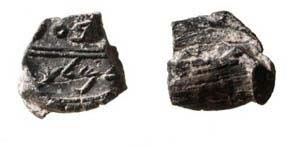Online Articles
How Ancient Taxes Were Collected Under King Manasseh
When April 15 rolls around this year, taxpayers may take some small comfort in the fact that taxes are by no means a modern invention. Benjamin Franklin and Mark Twain both famously remarked about the certainty of death and taxes, and a recent archaeological discovery concerning ancient taxes in Jerusalem has added to scholars' certainty about a tax system in ancient Israel, especially during the reign of Judah's King Manasseh.
 |
Discovered during the Temple Mount Sifting Project, this seventh-century B.C.E. clay bulla inscribed in paleo-Hebrew script with the phrase "Gibeon, for the king" provides new evidence for how ancient taxes were collected during the reign of the Biblical King Manasseh. |
While wet sifting soil from the excavation of an ancient refuse pit on the eastern slope of the Temple Mount, workers at the Temple Mount Sifting Project* discovered a small clay bulla, or seal impression, inscribed in paleo-Hebrew script. Although some of the letters had broken off, archaeologist and codirector of the sifting project Gabriel Barkay reconstructs the two lines of fragmentary paleo-Hebrew text to read "[g]b'n/lmlk," or "Gibeon, for the king." This puts the new find in a special group of more than 50 so-called fiscal bullae, but it is the first of these to come from a professional excavation; all of the previous examples are from the antiquities market (the Temple Mount Sifting Project subsequently discovered a second example while sifting soil from Ronny Reich and Eli Shukron's excavation near the Gihon Spring).
Unlike the lmlk jar handles familiar to our readers,** Barkay told Biblical Archaeology Review (BAR) by telephone that the fiscal bullae were not part of Hezekiah's administrative preparations for the siege of Jerusalem by the Assyrian king Sennacherib in 701 B.C. Rather, he thinks the bullae are evidence for a system of ancient taxes used by Hezekiah's son and successor, King Manasseh, in the seventh century B.C.E. Barkay told BAR that under this system, "the urban administrative centers collected [ancient] taxes in kind [i.e., grain, oil, etc.] and then sent them on to the king in Jerusalem with the documentation attached and sealed by these bullae identifying where it had come from—in this case, Gibeon." At least 19 cities are identified in the paleo-Hebrew inscriptions on the fiscal bullae, representing nine of the 12 districts of Judah listed in Joshua 15:20–63. Barkay suggests that this Biblical passage may even have been composed for purposes of administering and collecting ancient taxes during the reign of King Manasseh.
King Manasseh was not popular with the Biblical authors (as Barkay puts it, "they hated his guts"), but Assyrian records suggest that he implemented heavy taxes on his people in order to pay tribute to King Esarhaddon and then King Ashurbanipal, Sennacherib's successors in Assyria. These ancient taxes thus helped King Manasseh maintain relative peace in Judah during his 55-year reign. Other evidence from the paleo-Hebrew inscribed fiscal bullae indicates that the city of Lachish was rebuilt during this time, as Barkay told BAR, 16 years after its destruction by Sennacherib's invading army.
Proof once again that, when it comes to taxes, saving receipts is always a good idea.
Notes
* See Hershel Shanks, "Jerusalem Roundup," Biblical Archaeology Review, March/April 2011; Hershel Shanks, "Sifting the Temple Mount Dump," Biblical Archaeology Review, July/August 2005.
** See Gabriel Barkay, "Royal Palace, Royal Portrait," Biblical Archaeology Review, September/October 2006.




